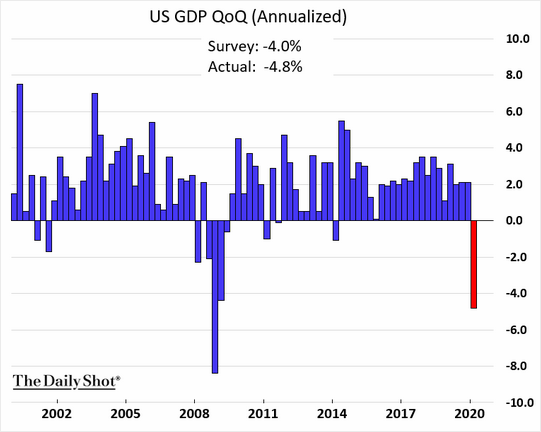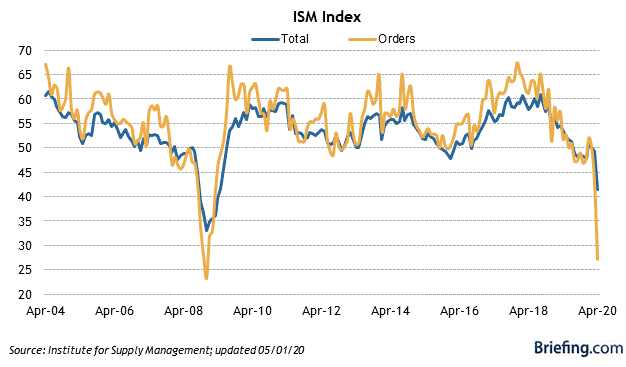Federal Reserve Statement: Last week the Federal Reserve issued an official statement, followed by a press conference with Fed Chair Jay Powell. From the statement: “The Federal Reserve is committed to using its full range of tools to support the U.S. economy in this challenging time, thereby promoting its maximum employment and price stability goals.”
The Federal Reserve is keeping rates near zero for the short to medium term. While the Fed has acted swiftly, Chairman Powell praised Congress for their quick fiscal actions (e.g., the Paycheck program, CARES, and other programs).
Chairman Powell acknowledged the human and economic toll stemming from the coronavirus, along with the expectation of continued negative effects. Powell stated they are monitoring the economic conditions, the health information, global challenges, and the potential for inflationary changes “and will use its tools and act as appropriate to support the economy.” He also stated the U.S. Treasury has additional equity that could be used if and when needed.
The timing of when the economy comes back is anyone’s guess. However, Chairman Powell expressed that the second quarter of 2020 will be worse than the first, and anticipates economic activity will increase in the second half of 2020. And it may take a year or longer to get back to where we were before the outbreak. He predicated these statements on the containment of the coronavirus, the creation of a vaccine, states lifting economic restrictions, and peoples’ willingness and comfort level to resume activity.
GDP First Quarter 2020
Last week the Bureau of Economic Analysis released the much-anticipated real GDP report for Q1 2020, which showed the economy contracted at an annualized rate of 4.8 percent. The last time GDP was negative was the first quarter 2014 (-1.1%). The BEA attributes the current decline to the response in combating COVID-19 as federal, state, and local governments issued shelter-in-place and various other orders. The BEA also acknowledged that the full effect of GDP could not be captured “because the impacts are generally embedded in source data and cannot be separately identified.”
In the first quarter 2020, personal consumption expenditures dropped 7.6 percent, with goods down 1.2 percent and services down 10.2 percent. Gross private domestic investment was down 5.6 percent; exports were down 8.7 percent and imports down 15.3 percent; government consumption expenditures and gross investment was the only major area showing an increase, up 0.7 percent.

Personal Income and Personal Spending
Personal income dropped 2.0% in March 2020 from the preceding month, mainly from a reduction of employee compensation as millions continue to file for unemployment. That was the biggest percentage decline since January 2013 (- 4.7 percent). Disposable personal income also decreased 2.0 percent and personal consumption expenditures (PCE) declined 7.5 percent. The PCE price index decreased 0.3 percent in March 2020. Showing the effect of declining energy prices (which were down 6.1 percent in March), the core PCE price index only decreased 0.1 percent.
Manufacturing PMI
The Institute for Supply Management reported last week that their manufacturing PMI reading fell from 49.1 in March to 41.5 in April, indicating “…the PMI indicates a level of manufacturing-sector contraction not seen since April 2009, with a strongly negative trajectory” given the impacts of the COVID-19 pandemic and recession in the energy sector.

Here’s what some of the ISM survey respondents had to say:
- “Thirty-percent decrease for April due to COVID-19 impact on both customers and suppliers.” (Computer & Electronic Products)
- “Production stopped, other than to make hand sanitizer for those in need.” (Chemical Products)
- “COVID-19 has created a wave of activities, including vendors closing, vendors focusing only on the medical industry, employees not coming to work, delayed shipments from overseas, etc.” (Transportation Equipment)
- “Our refinery is losing money making gasoline due to the falling demand.” (Petroleum & Coal Products)
- “We supply the construction industry in various ways, where the slowdown has been a bit slower than most industries. It is, however; beginning to impact our business, and we see more challenges on the horizon.” (Fabricated Metal Products)
- “Our packaging business is starting to see signs of a slowdown in May after two strong months into COVID-19.” (Paper Products)
- “COVID-19 has destroyed our market and our company. Without a full recovery very soon, and some assistance, I fear for our ability to continue operations.” (Nonmetallic Mineral Products)